Vibration Monitoring Market Size and Share
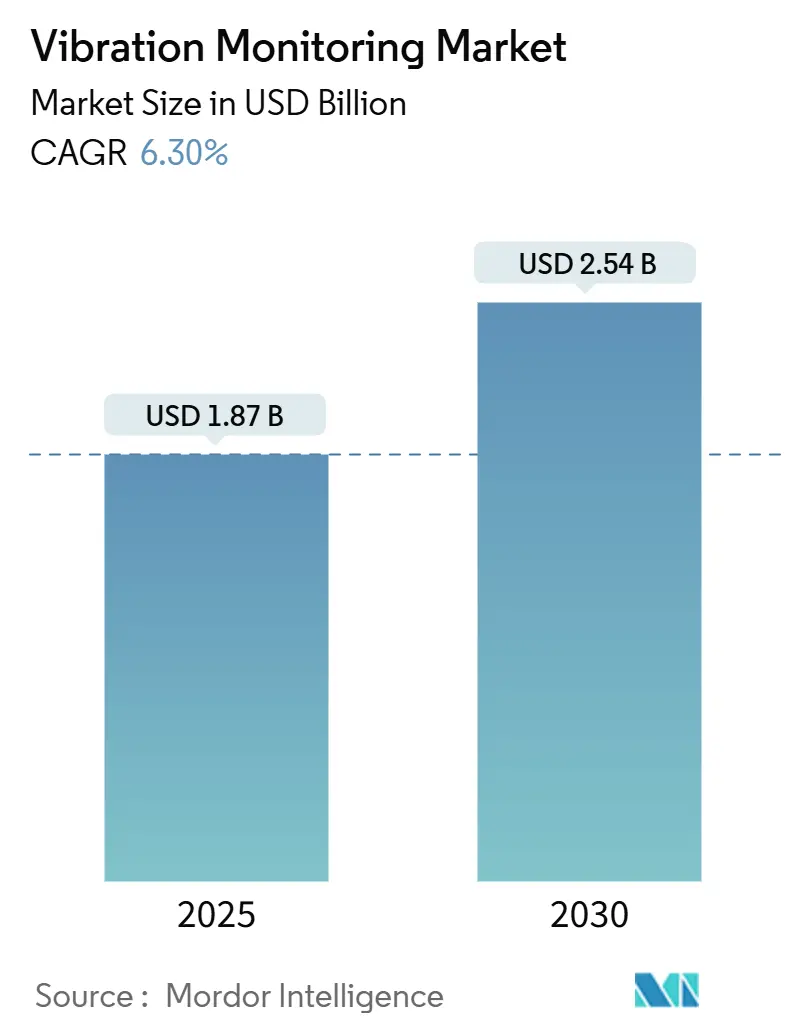
Vibration Monitoring Market Analysis by Mordor Intelligence
The vibration monitoring market is valued at USD 1.87 billion in 2025 and is projected to reach USD 2.54 billion by 2030, advancing at a 6.3% CAGR through the forecast period. Increasing recognition of the high cost of unplanned machinery failures is shifting maintenance strategies from reactive to predictive approaches, driving steady investment in condition-based monitoring across oil and gas, power generation, and discrete manufacturing. Wireless IIoT sensors, edge analytics, and cloud platforms are converging to reduce data-collection costs, extend coverage to hard-to-reach assets, and enable prescriptive insights that lengthen asset life. Heightened regulatory pressure in hazardous industries, the retirement deferment of aging coal-fired plants, and government-backed smart-manufacturing schemes in Asia further accelerate demand. Competitive intensity is rising as established automation majors fold vibration analytics into broader digital-twin ecosystems, raising entry barriers for stand-alone sensor suppliers and strengthening the long-term growth outlook for the vibration monitoring market.
Key Report Takeaways
- By component, hardware retained 62% of the vibration monitoring market share in 2024, while services posted the fastest 7.8% CAGR outlook to 2030.
- By monitoring process, online/continuous systems are expected to lead with a 55% revenue share of the vibration monitoring market in 2024; wireless remote monitoring is forecast to expand at a 9.2% CAGR through 2030.
- By network technology, wired installations accounted for 70% of the vibration monitoring market size in 2024; however, wireless networks are projected to grow at a 10.5% CAGR between 2025 and 2030.
- By end-user, the oil and gas sector commanded a 30% share of the vibration monitoring market size in 2024, while the food and beverage sector is projected to advance at an 8.5% CAGR from 2024 to 2030.
- By geography, North America dominated the vibration monitoring market, accounting for a 37% revenue share in 2024. Asia is expected to register the fastest CAGR of 8.6% from 2025 to 2030.
Global Vibration Monitoring Market Trends and Insights
Drivers Impact Analysis
| DRIVER | (~) % IMPACT ON CAGR FORECAST | GEOGRAPHIC RELEVANCE | IMPACT TIMELINE |
|---|---|---|---|
| Rising Adoption of Wireless IIoT-Enabled Sensors in Hazardous Zones | +1.8% | Global, with concentration in Middle East and North America offshore operations | Medium term (2-4 years) |
| Shift from Periodic to Online Continuous Monitoring in Power Generation Turbines | +1.5% | North America and Europe, expanding to Asia-Pacific | Long term (≥ 4 years) |
| Asset-criticality-based Predictive Maintenance Mandates by Offshore Oil and Gas Operators | +1.2% | Middle East core, spill-over to North Sea and Gulf of Mexico | Short term (≤ 2 years) |
| Government-funded Smart Manufacturing Programs Boosting MEMS Accelerometer Demand | +1.0% | Asia-Pacific core, with secondary impact in Europe | Medium term (2-4 years) |
| Aging Coal-Fired Plants Retrofitting Vibration Monitoring for Life-Extension | +0.8% | South America, Eastern Europe, and select Asia markets | Long term (≥ 4 years) |
| Integration of AI and Machine Learning in Predictive Analytics Platforms | +0.7% | Global, with early adoption in North America and Europe | Medium term (2-4 years) |
| Source: Mordor Intelligence | |||
Rising Adoption of Wireless IIoT-Enabled Sensors in Hazardous Zones
Wireless, intrinsically safe vibration sensors are replacing cabled solutions in refineries, chemical plants, and offshore rigs as operators seek to minimize human exposure and maintenance overheads. Emerson’s AMS Wireless Vibration Monitor, which operates on WirelessHART and provides a three-to-five-year battery life, illustrates how modern devices now combine triaxial accelerometry with embedded prescriptive analytics, enabling remote coverage of pumps, compressors, and steam traps. Aramco’s roll-out of 454 wireless vibration nodes at the Fadhili Gas Plant shows the scalability of these solutions in large-scale hazardous. Improved protocol security and edge processing continue to lower total cost of ownership, underpinning broader acceptance across the vibration monitoring market.[1]Emerson, “AMS Wireless Vibration Monitor,” emerson.com
Shift from Periodic to Online Continuous Monitoring in Power-Generation Turbines
Power utilities are abandoning route-based checks in favor of permanent sensors that stream high-resolution data to remote centers staffed by specialists in rotating equipment. GE Vernova’s Remote Monitoring and Diagnostics service connects thousands of steam- and gas-turbine data points to cloud analytics that spot anomalies one to two months before failure, allowing optimized shutdown scheduling. Combined-cycle plants benefit most because rapid load changes introduce vibration patterns that legacy quarterly checks overlook. With original-equipment manufacturers now bundling performance guarantees with continuous monitoring adherence, demand for always-on systems in the vibration monitoring market is poised to climb steadily.
Asset-Criticality-Based Predictive-Maintenance Mandates by Offshore Oil and Gas Operators
Producers in the Arabian Gulf, North Sea, and Gulf of Mexico classify rotating assets by failure consequence; compressors and water-injection pumps at the top tiers must now carry continuous vibration surveillance. Studies at UAE and Saudi fields show that integrating vibration, process, and lifetime-stress data cuts unplanned downtime on critical machines by double-digit percentages. Regulatory bodies are recognizing online condition monitoring as a formal risk-mitigation measure, reinforcing uptake across the vibration monitoring market.
Government-Funded Smart-Manufacturing Programs Boosting MEMS Accelerometer Demand
Asia’s smart-factory grants subsidize sensor retrofits, data platforms, and workforce training. China’s 2024 policy blueprint and Japan’s 2025 semiconductor roadmap both call for broad adoption of MEMS-based measurement devices in assembly lines. MEMS accelerometers offer lower power draw and tighter integration with industrial Ethernet, making them ideal for high-density installations. Subsidized roll-outs are creating a fast-growing demand pocket within the vibration monitoring market.
Restraints Impact Analysis
| RESTRAINTS | (~) % IMPACT ON CAGR FORECAST | GEOGRAPHIC RELEVANCE | IMPACT TIMELINE |
|---|---|---|---|
| Scarcity of Vibration Analysts with ISO 18436-2 Certification | -1.1% | Global, particularly acute in emerging markets | Long term (≥ 4 years) |
| Cyber-hardening Costs for Cloud-connected Monitoring Gateways | -0.9% | North America and Europe, expanding globally | Medium term (2-4 years) |
| Low ROI Perception in Low-runtime Batch Food Processing Lines | -0.6% | Global, with concentration in emerging food processing markets | Medium term (2-4 years) |
| Fragmented Wireless Standards Causing Interoperability Issues | -0.4% | Global, with particular impact on multi-vendor installations | Short term (≤ 2 years) |
| Source: Mordor Intelligence | |||
Scarcity of Vibration Analysts with ISO 18436-2 Certification
Modern systems generate large, complex data sets that still need expert interpretation to confirm machine faults. Training an analyst to ISO 18436-2 level takes two to three years, and supply lags industrial demand, especially in fast-growing economies. Many firms respond by outsourcing diagnostics or deploying automated analytics, yet intricate turbomachinery failures often require human judgement, tempering expansion in parts of the vibration monitoring market.[2]Analog Devices, “MEMS Accelerometers for Condition Monitoring,” analog.com
Cyber-Hardening Costs for Cloud-Connected Monitoring Gateways
Encrypting data streams, segmenting OT/IT networks, and complying with IEC 62443 or ISO 27001 add 20–30% to project budgets. Operators with thin margins delay upgrades until security templates mature or hybrid architectures prove affordable. The cost burden is most acute for small and medium enterprises, slowing cloud-based adoption in sections of the vibration monitoring market.
Segment Analysis
By Component: Services Drive Value Creation
Hardware led the vibration monitoring market with 62% revenue in 2024, underscoring the central role of accelerometers, velocity pickups, and proximity probes in every installation. Accelerometers dominate because they span wide frequency ranges and mount easily on pumps, motors, and gearboxes, while displacement transducers remain mandatory on high-speed turbines. The hardware share is expected to moderate as MEMS and optical sensors widen application scope and reduce node cost. Services, however, post the strongest 7.8% CAGR through 2030 as users shift toward outcome-based contracts that bundle data analytics, diagnostics, and maintenance recommendations. Software evolves in parallel, migrating from on-premise spectrum viewers to cloud platforms that apply machine learning and digital-twin correlation, enabling vendors to lock in recurring revenue. TDK’s Tronics AXO 315, a digital, force-rebalance MEMS accelerometer, exemplifies how firmware-rich sensors blur the line between hardware and software services.
The growing emphasis on predictive insights positions service providers as strategic partners rather than transactional suppliers. Managed-service contracts that charge per monitored asset or per avoided downtime align incentives and amplify demand for analytics subscriptions. Large automation houses leverage global service networks to capture this value, while niche diagnostic firms specialize in complex failure modes. As labor shortages tighten, automated diagnostics gain favor, reinforcing service-led growth across the vibration monitoring market.[3]TDK Corporation, “Tronics AXO 315 Press Release,” tdk-electronics.tdk.com
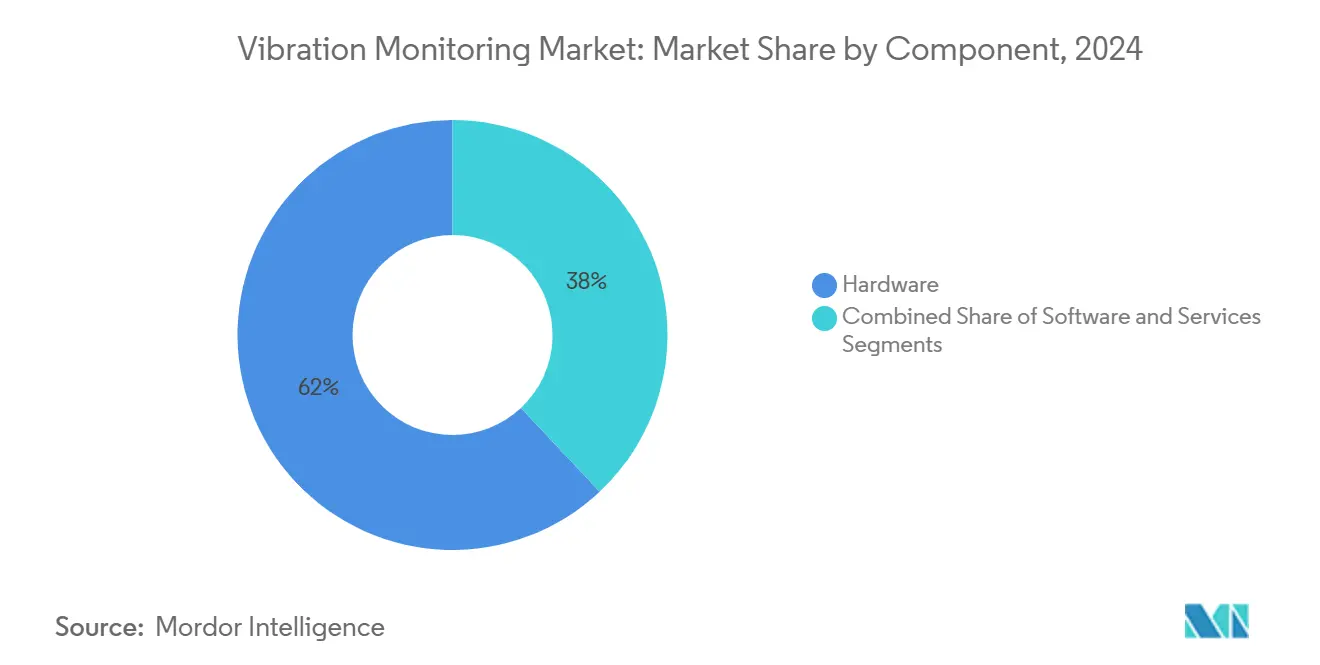
Note: Segment shares of all individual segments available upon report purchase
By Monitoring Process: Wireless Remote Gains Momentum
Online continuous monitoring captured 55% of 2024 revenue, a position it will hold as long as critical equipment such as turbines, compressors, and extruders require around-the-clock oversight. Continuous data streams allow trending of spectral signatures and early identification of transient events that route-based measurements miss. Portable systems still serve lower-criticality assets, yet cost reductions in wireless sensing are tilting budgets toward permanent nodes that combine vibration and temperature channels on a single device.
Wireless remote monitoring is forecast to rise at a 9.2% CAGR. Battery-powered nodes now sustain three-plus years of life, and industrial-grade mesh protocols provide deterministic latency suitable for protection logic. Emerson reports deployments of thousands of wireless vibration points per site, proving viable scale for large complexes. Edge-resident analytics further lower bandwidth needs by transmitting only pre-filtered indicators. As these advantages compound, the vibration monitoring market increasingly favors wireless architectures for both greenfield and retrofit projects.
By Deployment Mode: Cloud Adoption Accelerates
On-premises installations held 80% share in 2024, reflecting operator preference for local control and real-time integration with safety systems. Legacy SCADA and distributed-control frameworks rely on deterministic networks that are difficult to replicate over public clouds. Cyber-security concerns, data-sovereignty rules, and intermittent connectivity at remote sites further sustain on-prem footprints.
Cloud and SaaS deployments, however, are projected to scale at 12% CAGR. Centralized analytics pool multi-plant data sets, enabling comparative benchmarking and algorithm training impossible within siloed servers. Large enterprises cut IT overhead by shifting to vendor-hosted platforms that deliver continuous updates and AI models. Hybrid architectures, where gateways perform first-level processing and push exceptions to the cloud, balance latency and security, encouraging adoption. As a result, broader cloud penetration will expand total addressable revenue in the vibration monitoring market.
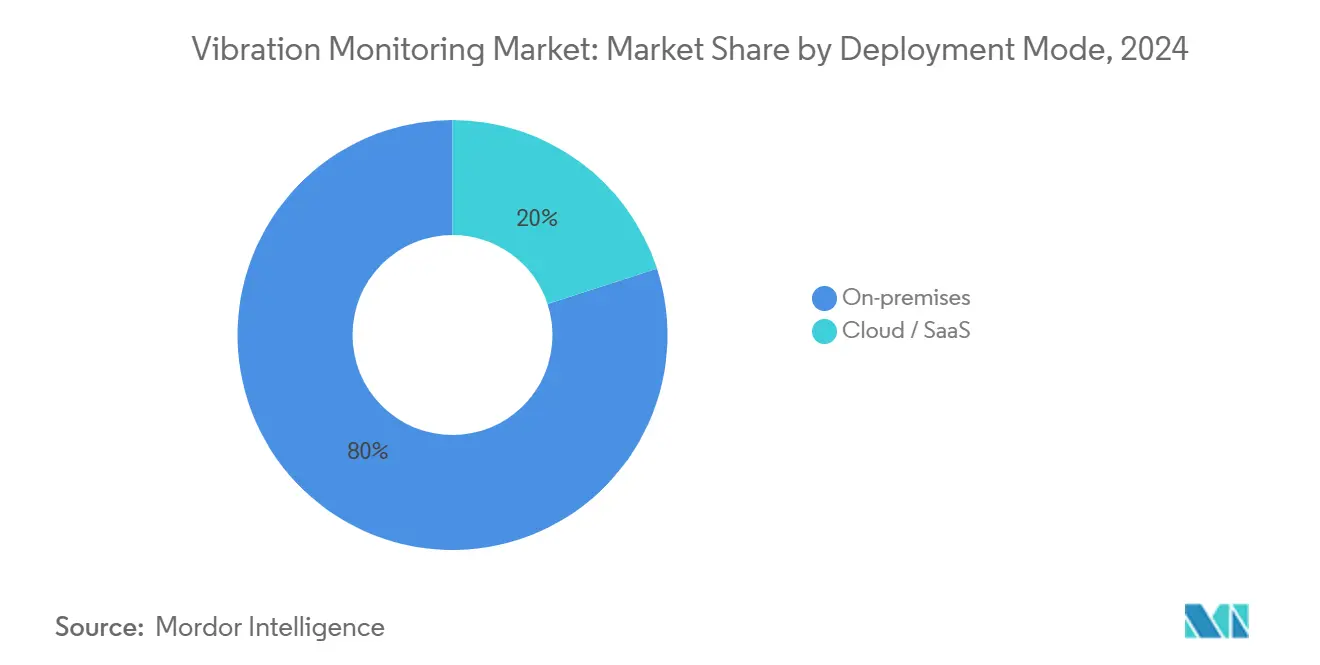
By Network Technology: Wireless Standards Mature
Wired links 4-20 mA, HART, or Ethernet retained 70% market share in 2024, prized for reliability and embedded power supply. Critical turbomachinery monitoring still favors shielded cables to guarantee data integrity. Existing conduit infrastructure also lowers incremental costs during retrofits, thereby reinforcing the prevalence of wired solutions.
Wireless systems, however, are expected to grow at a 10.5% CAGR. The ISA100.11a and 6LoWPAN stacks now incorporate robust encryption and QoS layers, while device certification programs help alleviate concerns about multivendor interoperability. Aramco’s ISA100 deployment for both steam-trap and vibration sensing validates field-proven performance at the petrochemical scale. Concurrent 5G roll-outs add high-bandwidth options for mobile assets. These advances facilitate wider adoption of wireless technology across the vibration monitoring market.
Geography Analysis
North America led with 37% of 2024 revenue, propelled by offshore oil and gas regulations that mandate online condition monitoring, plus large-scale retrofits in the United States power sector. Utilities extending the life of coal-fired units and combined-cycle plants underpin continual sensor demand, while Canada’s oil sands operations require robust devices that withstand extreme cold and dust. Government emphasis on workplace safety also promotes investment, cementing the region’s dominance in the vibration monitoring market.
Europe maintains a sizeable share on the strength of its manufacturing base and energy-efficiency legislation. Germany champions Industry 4.0 roll-outs that couple vibration data with MES and ERP systems for holistic asset views. The United Kingdom’s North Sea operators invest heavily in wireless mesh sensing to overcome hazardous-area cabling costs, while the EU’s stringent machinery directives embed condition monitoring within risk-assessment frameworks. These factors create stable, compliance-driven demand that supports the vibration monitoring market across the continent.
Asia-Pacific posts the fastest 8.6% CAGR, buoyed by Chinese, Japanese, and Indian smart-manufacturing incentives that subsidize sensor adoption. Semiconductor strategies emphasizing local MEMS production further reduce device cost. Rapid industrialization across Southeast Asia and government efforts to digitalize SMEs expand the addressable base. Adoption of wireless protocols and cloud analytics is swift in new plants unencumbered by legacy systems, positioning the region as a key growth engine for the vibration monitoring market.
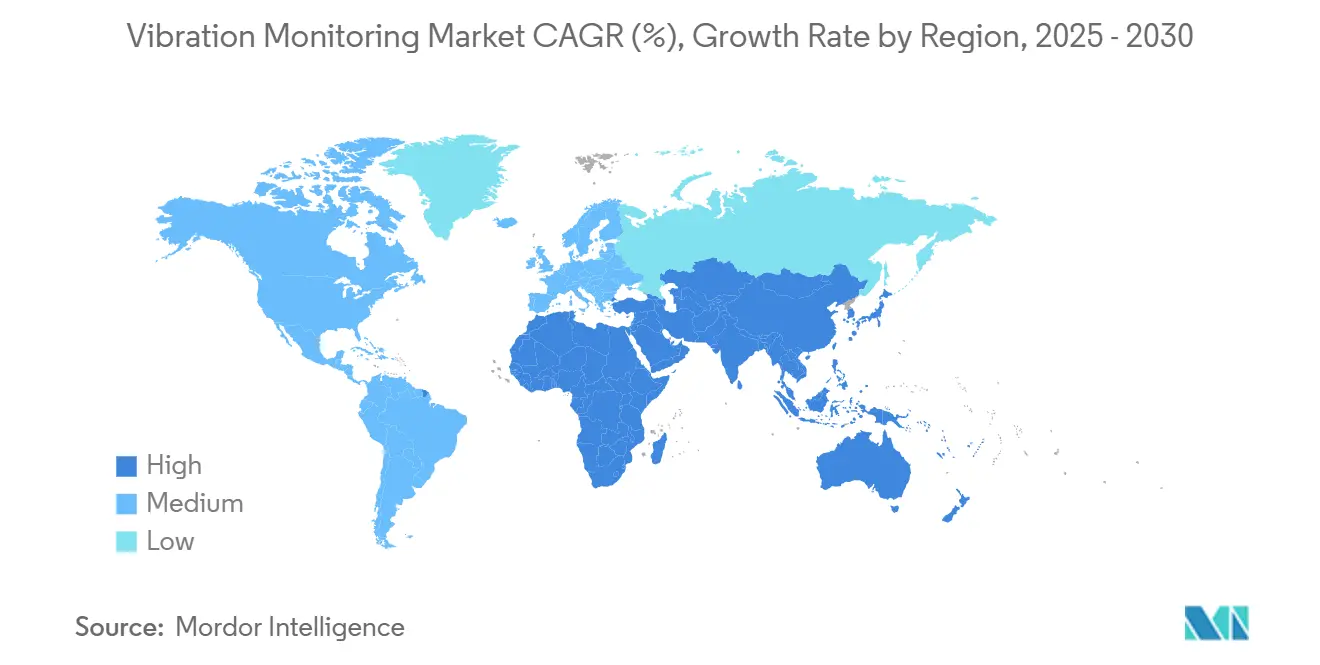
Competitive Landscape
The vibration monitoring industry exhibits moderate fragmentation, yet consolidation is accelerating as automation majors acquire sensor specialists to offer end-to-end predictive maintenance suites. In a strategic move, SKF has bolstered its portfolio by acquiring the lubrication arm of John Sample Group (JSG). This acquisition not only integrates JSG's advanced lubrication and flow management systems but also enhances SKF's established lineup of bearings, seals, and mechatronics. With this expansion, SKF is poised to deliver more holistic reliability solutions, especially targeting growth and enhanced capabilities in the Asia-Pacific market. Honeywell’s planned acquisition of Sundyne adds high-speed pumps and compressors that naturally complement its Forge analytics platform, underscoring a strategy to secure aftermarket parts and monitoring contracts.
Technology differentiation centers on edge AI and integrated digital twins. Vendors embed DSP chips inside sensors that run anomaly-detection models locally, cutting bandwidth and latency while addressing data-sovereignty concerns. Cloud dashboards amalgamate vibration, process, and lubrication data, generating prescriptive work orders that feed enterprise asset-management systems. Regal Rexnord’s next-generation Perceptiv platform typifies this shift, offering a universal gateway for multi-sensor fusion and AI-driven maintenance scheduling.
Barriers for smaller firms rise as customers demand cyber-secure, fully integrated solutions. However, niches remain for innovators focused on batteryless energy-harvesting nodes or specialized fault libraries for wind turbines and rail bogies. White-label partnerships with automation giants provide go-to-market channels, ensuring continued diversity within the vibration monitoring market.
Vibration Monitoring Industry Leaders
-
Emerson Electric Co.
-
Honeywell International Inc.
-
General Electric (Baker Hughes)
-
Rockwell Automation Inc.
-
SKF Ltd.
- *Disclaimer: Major Players sorted in no particular order
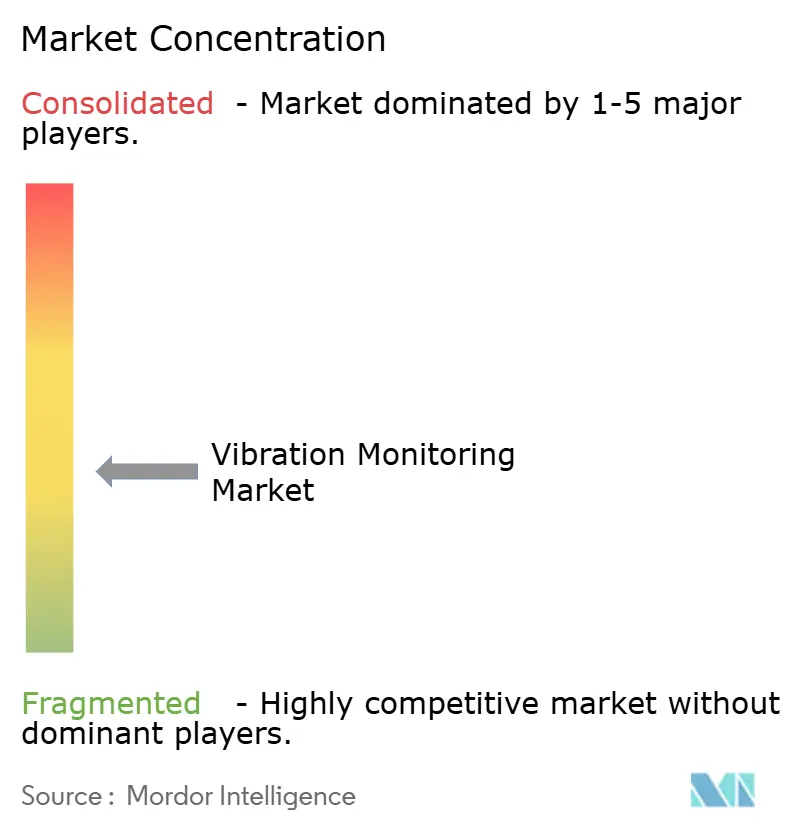
Recent Industry Developments
- March 2025: Honeywell announced its acquisition of Sundyne, a leader in pumps and gas compressors for process industries, to enhance its Energy and Sustainability Solutions segment and integrate Sundyne's technology with Honeywell's IoT platform Forge. The deal aims to generate revenue synergies and improve aftermarket services, positioning Honeywell to better serve refining, LNG, and renewable fuels markets with the transaction expected to close in Q2 2025.
- February 2025: Regal Rexnord Corporation launched the next generation of its Perceptiv Intelligent Reliability and Maintenance Solution, featuring a Universal Gateway and wireless vibration and temperature sensors that provide unified architecture for predictive maintenance. The enhanced platform demonstrates 55% reduction in expected failures, 40% increase in machine life, and average annual savings of USD 250,000 for customers through integrated AI and machine learning capabilities.
- February 2025: ABB implemented condition monitoring services for Tenaris's electric motors at its Dalmine factory using ABB Ability MACHsense-R system and Smart Sensors for remote monitoring. The deployment enables detection of anomalies such as vibrations indicating bearing failure, allowing Tenaris to plan maintenance activities effectively and ensure operational efficiency in their continuous production environment.
- January 2025: GE Vernova enhanced its Remote Monitoring and Diagnostics services for steam power plant assets, providing 24/7 support through automatic and expert-assisted analysis of operational data. The service enables proactive maintenance through continuous monitoring, advanced analytics, and customizable modules that help mitigate risks, reduce unplanned outages, and improve asset lifecycle management.
Global Vibration Monitoring Market Report Scope
Vibration monitoring is a fundamental concept in industrial machinery dynamic control. With the advancement of technology, current vibration monitoring systems that integrate complexity and performance can provide workers with comprehensive, near-real-time diagnostic information on the machines' actual dynamic state and implementation. Structural vibration monitoring is another market component that is extremely important as a target for business generation in the market for vendors.
The vibration monitoring market is segmented by type (hardware (displacement, velocity, and acceleration), software, and services), end-user industry (automotive, oil and gas, energy and power, mining, food and beverage, and chemicals), and geography (North America, Europe, Latin America, Asia-Pacific, and the Middle East and Africa).
The market sizes and predictions are provided in terms of value in USD for all the above segments.
| Hardware | Accelerometers |
| Velocity Sensors | |
| Displacement/Proximity Probes | |
| Other Hardware (MEMS, Piezo, Optical) | |
| Software | |
| Services |
| Online/Continuous |
| Portable/Route-based |
| Wireless Remote (Edge and Cloud) |
| On-premises |
| Cloud / SaaS |
| Wired (4-20 mA, Modbus, Ethernet) |
| Wireless (BLE, ISA100, 6LoWPAN) |
| Motors and Pumps |
| Turbines and Compressors |
| Gearboxes and Bearings |
| Fans and Blowers |
| Oil and Gas |
| Energy and Power |
| Automotive and Transportation |
| Chemicals and Petrochemicals |
| Mining and Metals |
| Food and Beverage |
| Aerospace and Defense |
| Pulp and Paper |
| Marine |
| Other Industries |
| North America | United States |
| Canada | |
| Mexico | |
| Europe | United Kingdom |
| Germany | |
| France | |
| Italy | |
| Spain | |
| Rest of Europe | |
| Asia-Pacific | China |
| Japan | |
| India | |
| South Korea | |
| Australia | |
| Rest of Asia-Pacific | |
| Middle East | Israel |
| Saudi Arabia | |
| United Arab Emirates | |
| Turkey | |
| Rest of Middle East | |
| Africa | South Africa |
| Egypt | |
| Rest of Africa | |
| South America | Brazil |
| Argentina | |
| Rest of South America |
| By Component | Hardware | Accelerometers |
| Velocity Sensors | ||
| Displacement/Proximity Probes | ||
| Other Hardware (MEMS, Piezo, Optical) | ||
| Software | ||
| Services | ||
| By Monitoring Process | Online/Continuous | |
| Portable/Route-based | ||
| Wireless Remote (Edge and Cloud) | ||
| By Deployment Mode | On-premises | |
| Cloud / SaaS | ||
| By Network Technology | Wired (4-20 mA, Modbus, Ethernet) | |
| Wireless (BLE, ISA100, 6LoWPAN) | ||
| By Application | Motors and Pumps | |
| Turbines and Compressors | ||
| Gearboxes and Bearings | ||
| Fans and Blowers | ||
| By End-user Industry | Oil and Gas | |
| Energy and Power | ||
| Automotive and Transportation | ||
| Chemicals and Petrochemicals | ||
| Mining and Metals | ||
| Food and Beverage | ||
| Aerospace and Defense | ||
| Pulp and Paper | ||
| Marine | ||
| Other Industries | ||
| By Geography | North America | United States |
| Canada | ||
| Mexico | ||
| Europe | United Kingdom | |
| Germany | ||
| France | ||
| Italy | ||
| Spain | ||
| Rest of Europe | ||
| Asia-Pacific | China | |
| Japan | ||
| India | ||
| South Korea | ||
| Australia | ||
| Rest of Asia-Pacific | ||
| Middle East | Israel | |
| Saudi Arabia | ||
| United Arab Emirates | ||
| Turkey | ||
| Rest of Middle East | ||
| Africa | South Africa | |
| Egypt | ||
| Rest of Africa | ||
| South America | Brazil | |
| Argentina | ||
| Rest of South America | ||
Key Questions Answered in the Report
What is the current size of the vibration monitoring market?
The vibration monitoring market size stands at USD 1.87 billion in 2025 and is projected to reach USD 2.54 billion by 2030.
Which region dominates the vibration monitoring market?
North America leads with 37% of global revenue in 2024, driven by stringent safety regulations and extensive retrofit activity.
Why are wireless vibration sensors gaining popularity?
Wireless IIoT sensors cut installation costs, improve worker safety in hazardous zones, and now offer multi-year battery life with embedded analytics, supporting a 9.2% CAGR for wireless remote monitoring.
Which end-user industry is growing fastest?
Food and beverage is expanding at an 8.5% CAGR as continuous processing lines demand higher uptime and contamination avoidance.
What is hindering faster adoption of cloud-based monitoring?
Cyber-hardening requirements add 20–30% to project costs and raise data-sovereignty concerns, especially for small and mid-sized firms.
Are skilled analysts still needed with AI diagnostics?
Yes; while automated models handle routine faults, complex turbomachinery events often require ISO 18436-2-certified specialists, and a global shortage of such talent persists.
Page last updated on:



